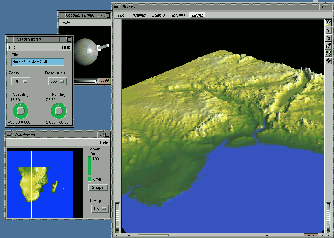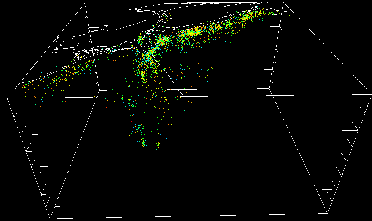Application Development with IRIS Explorer
Paul Morin,
The University of Minnesota's Geology Department
The University of Minnesota's geology department
uses IRIS Explorer to develop modules for student projects
and for distribution to earth scientists around the world
The ease in which application development can be done in IRIS
Explorer(TM) is a key feature of the product. Paul Morin, a
visualization programmer in the geology and geophysics department
of the University of Minnesota, counts on IRIS Explorer to create
applications for research and educational use.
 Morin and his colleagues have developed numerous modules, called
the "Minnesota Modules," to visualize earth sciences data, including
studies of earthquakes, digital elevation maps and global heat flow.
These modules are distributed free of charge via the internet to
other earth scientists. Because some modules are created by master's
students in computational science, the ease-of-use in developing
applications is a fundamental reason Morin has chosen IRIS Explorer
for use in his classes.
Morin and his colleagues have developed numerous modules, called
the "Minnesota Modules," to visualize earth sciences data, including
studies of earthquakes, digital elevation maps and global heat flow.
These modules are distributed free of charge via the internet to
other earth scientists. Because some modules are created by master's
students in computational science, the ease-of-use in developing
applications is a fundamental reason Morin has chosen IRIS Explorer
for use in his classes.
"Most computer science students are taught algorithms, but not about
data," says Morin. "My background and previous research into
earthquakes and other environmental studies allows me to provide
the students with complex datasets that they then can use, with
IRIS Explorer, to construct real-world applications relatively
quickly." In fact, in a recent scientific visualization course,
several students were able to write modules and create useable
applications in an average of just 40 hours, without previous
knowledge of IRIS Explorer. Morin describes some of the resulting
applications as "ground-breaking" and "the first step in tieing
IRIS Explorer to other application software."
 Some of the Minnesota Modules include Projector, which projects 2D
and 3D data onto more than a dozen standard map projections;
CoordCrop, which allows large georeferenced datasets to be cropped
by latitude, longitude, depth and elevation; CropQuake, which crops
earthquake data by longitude, latitude, depth, year and date
orientation; and Beachballs, which displays focal mechanism solutions
as 3D "beachballs" or as two crossed lines, and is "breaking new
ground in seismology."
Some of the Minnesota Modules include Projector, which projects 2D
and 3D data onto more than a dozen standard map projections;
CoordCrop, which allows large georeferenced datasets to be cropped
by latitude, longitude, depth and elevation; CropQuake, which crops
earthquake data by longitude, latitude, depth, year and date
orientation; and Beachballs, which displays focal mechanism solutions
as 3D "beachballs" or as two crossed lines, and is "breaking new
ground in seismology."
Morin has used IRIS Explorer since version 0.8 for Silicon Graphics
workstations, and feels NAG's current work in porting the product
to numerous platforms is extremely important for users in all
applications. "Explorer's ability to perform at a high standard on
multiple platforms is absolutely necessary, especially in our
setting. I can let students know Explorer is available and they can
work on whatever machine they may have access to, being confident
that it is performing the same on all machines."
 "As datasets grow larger and larger, interactive visualization becomes
an important part of the scientific process," states Morin. "We need
a fully functional, affordable visualization application environment.
We need to use the visualizations in the classroom; we need software
that can be on everyone's desk. This means we must have numerous
licenses at the cost of single licenses of other visualization
software. IRIS Explorer fits both of these needs perfectly."
"As datasets grow larger and larger, interactive visualization becomes
an important part of the scientific process," states Morin. "We need
a fully functional, affordable visualization application environment.
We need to use the visualizations in the classroom; we need software
that can be on everyone's desk. This means we must have numerous
licenses at the cost of single licenses of other visualization
software. IRIS Explorer fits both of these needs perfectly."
Last modified: Thu Jan 16 16:18:12 1997
[ Posters Home ]
© The Numerical Algorithms Group Ltd, Oxford UK, 1996.
 Morin and his colleagues have developed numerous modules, called
the "Minnesota Modules," to visualize earth sciences data, including
studies of earthquakes, digital elevation maps and global heat flow.
These modules are distributed free of charge via the internet to
other earth scientists. Because some modules are created by master's
students in computational science, the ease-of-use in developing
applications is a fundamental reason Morin has chosen IRIS Explorer
for use in his classes.
Morin and his colleagues have developed numerous modules, called
the "Minnesota Modules," to visualize earth sciences data, including
studies of earthquakes, digital elevation maps and global heat flow.
These modules are distributed free of charge via the internet to
other earth scientists. Because some modules are created by master's
students in computational science, the ease-of-use in developing
applications is a fundamental reason Morin has chosen IRIS Explorer
for use in his classes.

